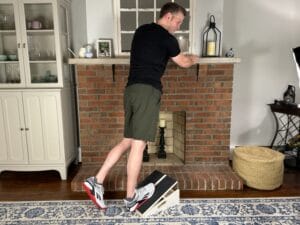Looking for the Best Exercises After an LCL Sprain?
Pain on the outside of your knee, trouble trusting your leg with side-to-side movements, and sharp discomfort during pivoting are all common signs of an LCL sprain. The lateral collateral ligament helps control varus forces—the outward pull on the knee—so even simple walking can feel unstable during early recovery.
The good news? With the right exercises—done safely at home—you can reduce pain, restore knee motion, and rebuild the lateral stability your knee relies on. I have come up with a list of the best lateral collateral ligament sprain exercises at home, that you can easily follow on a daily basis.
As a Doctor of Physical Therapy, I’ve helped hundreds of patients recover from knee ligament sprains. The key is performing the right exercises at the right time, progressing gradually from gentle mobility to strength and balance work that supports the outer knee.
Before you begin, you may also benefit from:
Let’s start with Phase 1, where your goals are to calm irritation, control swelling, and gently restore motion without placing varus stress on the ligament.
Want a quick-reference PDF? Scroll down to the bottom of this post to grab your free printable plan!
Disclaimers and Disclosures: All information in this article is for informational and educational purposes only and should not be taken as individual medical advice. Additionally, this article contains affiliate links, meaning when you make a purchase, we make a small commission at no additional cost to you. For more information, see our full Disclaimers and Disclosures.
Phase 1 (0–3 Weeks): Early LCL Sprain Exercises at Home
During the first three weeks after an LCL sprain, the goal is to calm the outer knee, reduce swelling, and restore gentle knee motion. This phase focuses on muscle activation without stressing the lateral structures.
This routine should be completed twice per day, stopping or modifying any exercise that increases pain on the outer knee.
This program was created by a Doctor of Physical Therapy and Orthopedic Clinical Specialist. Always consult your healthcare provider before beginning any exercise regimen.
1. Calf Stretch with Strap
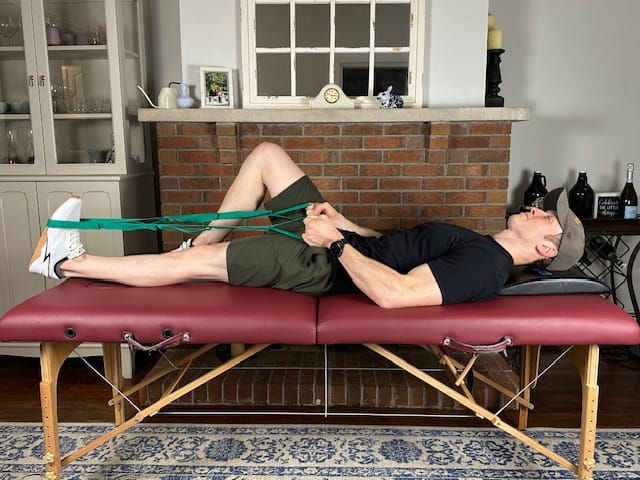
- Purpose: Stretch the gastrocnemius to improve ankle and knee mechanics.
- Benefits: Promotes full knee extension and reduces compensations that load the outer knee.
- How to Do It:
- Sit with your leg straight and loop a strap around the ball of your foot.
- Gently pull your toes toward you until you feel a stretch in the calf.
- Hold for 20 seconds, repeat 5 times.
- Helpful Link: Best Stretching Strap with loops can be found in the link below.
2. Hamstring Stretch with Strap

- Purpose: Reduce posterior thigh tightness that can restrict motion and irritate the outer knee.
- Benefits: Supports smoother knee extension and walking mechanics.
- How to Do It:
- Lie on your back, loop a strap around your foot, and keep your leg straight.
- Lift your leg until you feel a stretch in the back of your thigh.
- Hold for 20 seconds, repeat 5 times.
- Pro Tip: Keep your opposite leg flat on the table to feel a better stretch in the hamstring.
3. Straight Leg Raise
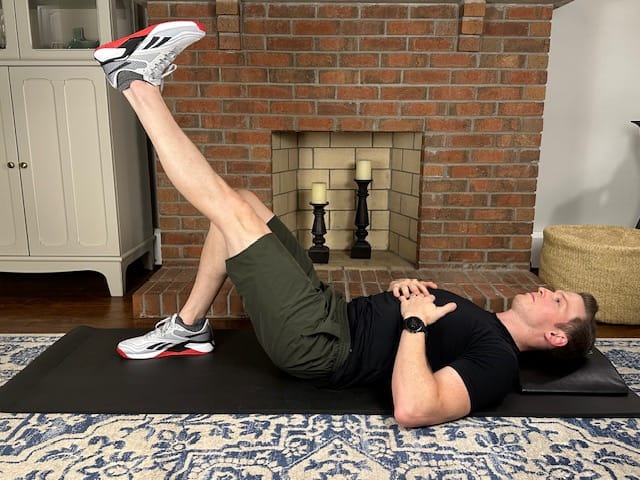
- Purpose: Build quad strength without stressing the LCL.
- Benefits: Supports knee stability and improves muscle control following an LCL injury.
- How to Do It:
- Lie on your back with one leg bent and the other straight.
- Tighten your thigh and lift the straight leg to the height of your bent knee, then lower slowly.
- Repeat for 10 reps and complete 2 sets..
- Helpful Link: Best Thick Yoga Mat to lie on for comfort can be found in the link below.
4. Quad Set

- Purpose: Engage the quadriceps to prevent early muscle loss.
- Benefits: Improves knee control and supports lateral stability.
- How to Do It:
- Lie on your back with a towel roll under your ankle.
- Tighten your thigh to press the knee down.
- Hold for 2 seconds, perform 30 reps.
- Pro Tip: Really focus on the contraction on the front of your thigh while pressing your knee straight.
5. Short Arc Quad
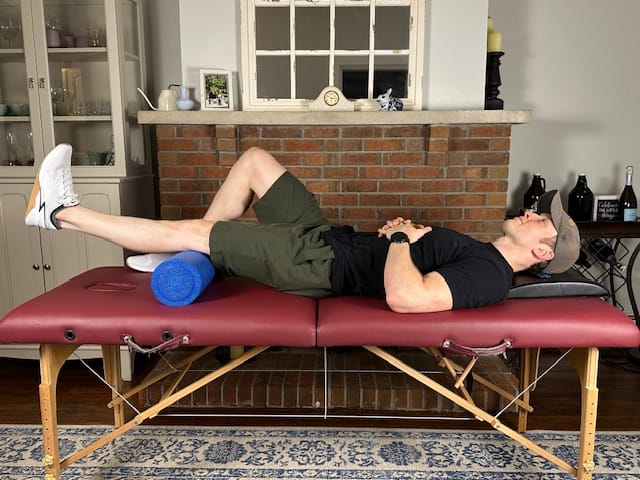
- Purpose: Strengthens quads through a controlled arc of motion.
- Benefits: Helps restore knee extension and supports proper alignment after LCL sprain.
- How to Do It:
- Rest your knee over a foam roll while lying on your back.
- Straighten the knee by lifting your heel off the surface, pause briefly at the top.
- Lower slowly and repeat 20 times for 2 sets.
- Helpful Link: Best Ankle Weights and Foam Roll can be found in the links below.
6. Long Arc Quad
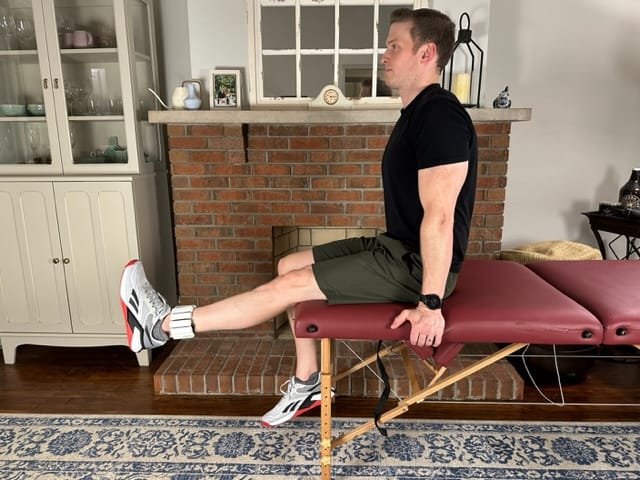
- Purpose: Strengthens the quadriceps through a larger range of motion.
- Benefits: Prepares for walking, sit-to-stand, and stairs after an LCL injury.
- How to Do It:
- Sit upright with your thigh supported.
- Slowly extend your leg fully, hold briefly, then lower.
- Perform 20 reps, complete 2 sets.
- Pro Tip: Increase the ankle weight slowly over time and focus on controlled reps.
7. Heel Slides
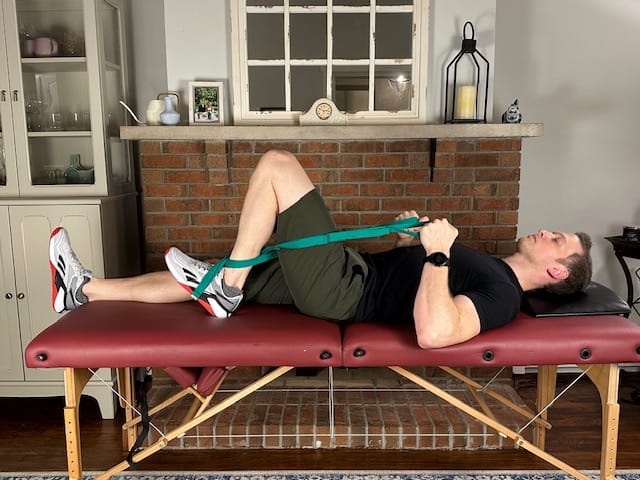
- Purpose: Restore knee bending in a controlled and safer way.
- Benefits: Prevents stiffness and promotes healthy joint motion with and LCL sprain.
- How to Do It:
- Loop a strap around your foot.
- Slide your heel slowly toward your buttocks, keeping your foot on the surface.
- Hold for 10 seconds and repeat 10 times.
- Helpful Link: Best Stretching Strap with loops can be found in the link below.
Bonus: Ice Pack and TENS for LCL Injury Pain and Swelling
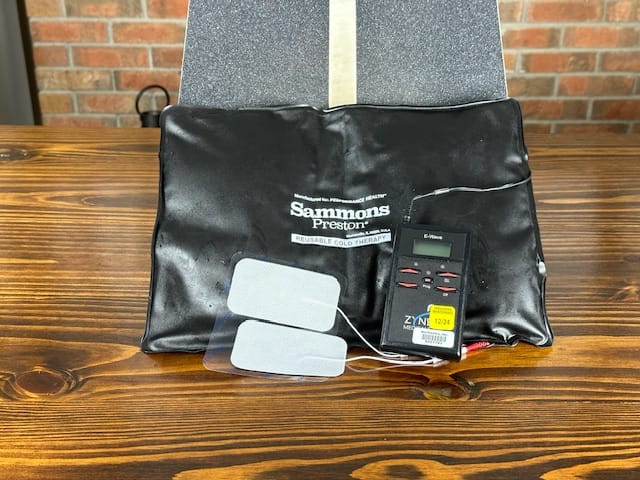
- Purpose: Reduce pain, inflammation, and muscle inhibition during early recovery.
- Benefits: Enhances comfort and reduces swelling, especially after exercise.
- How to Use:
- Place TENS pads just over the painful area of the knee.
- Apply ice for 10–15 minutes post-exercise.
- Helpful Link: Best Ice Pack and TENS Unit can be found in the links below.
Phase 2 (3–6 Weeks): LCL Sprain Exercises at Home for Strength and Stability
As pain decreases and movement improves, this phase introduces light strengthening and controlled lateral stability work. The focus is on restoring muscle support around the knee without provoking varus stress.
These exercises should be completed once per day. Continue the stretching exercises from phase 1.
This program was created by a Doctor of Physical Therapy and Orthopedic Clinical Specialist. As always, be sure to consult your healthcare provider before starting any new exercise regimen.
1. Heel Raises & Toe Raises

- Purpose: Train calf and shin muscles for improved gait mechanics.
- Benefits: Enhances ankle stability and reduces compensations that load the LCL.
- How to Do It:
- Stand tall and slowly rise onto your toes, then rock back onto your heels.
- Move with control, not momentum.
- Perform 15 reps, repeat for 2 sets.
- Pro Tip: Wear supportive Minimalist Shoes for ease while doing your standing exercises.
2. Cone Step-Overs
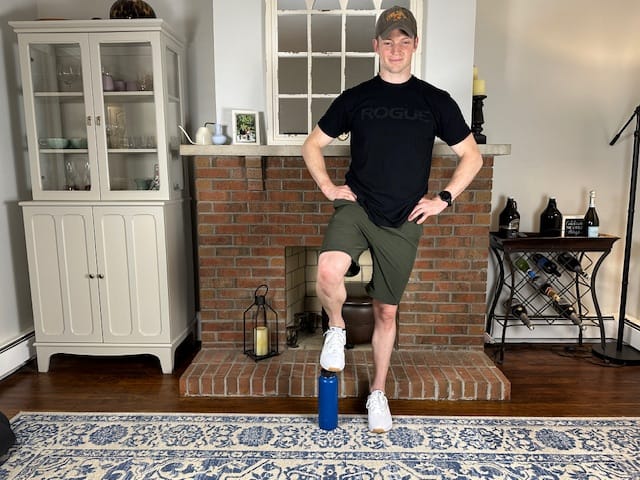
- Purpose: Encourages active knee bending and lateral step control.
- Benefits: Improves coordination without stressing the lateral knee early on.
- How to Do It:
- Set up a cone if front or your counter or other stable surface.
- Start on one side and step laterally over the cone, and then back to your start position.
- Over and back counts as one rep, complete 30 reps.
- Pro Tip: Use different objects to increase the height and make it a greater challenge.
3. Single Leg Stance

- Purpose: Retrains balance and joint proprioception after LCL injury.
- Benefits: Reduces reinjury by improving neuromuscular control.
- How to Do It:
- Stand on your injured leg in front of a counter for support.
- Lift your hands off the counter and balance for 15 seconds.
- Repeat on the other side and complete 5 sets.
- Helpful Link: Best Balance Pad to progress to can be found in the link below.
4. Step-Ups (Forward)

- Purpose: Strengthen quads and glutes in a functional pattern.
- Benefits: Prepares for stairs and walking after LCL sprain.
- How to Do It:
- Stand in front of a step with a counter nearby for balance.
- Step up with your injured leg, then lower with control.
- Repeat on the other side, perform 10 reps, complete 2 sets.
- Helpful Link: Best Adjustable Stepper can be found in the link below.
5. Lateral Step-Overs

- Purpose: Strengthen hips and knees in a lateral movement.
- Benefits: Improves medial-lateral control without aggressive varus force.
- How to Do It:
- Stand beside the step and step laterally up with your outer leg.
- Bring the other leg up, then step down to the other side.
- Return to start in the same fashion, complete 10 reps and perform 2 sets.
- Pro Tip: Start on a low step and focus on knee alignment as you go over the step.
6. Bridges with Band

- Purpose: Strengthen glutes and hamstrings for better knee alignment.
- Benefits: Reduces lateral knee strain by improving hip control.
- How to Do It:
- Lie on your back with knees bent and band above knees.
- Squeeze glutes and lift hips off the floor, hold for 2 seconds at the top.
- Perform 15 repetitions and complete 2 sets.
- Helpful Link: Best Resistance Bands can be found in the link below.
Phase 3 (6+ Weeks): Lateral Collateral Ligament Sprain Exercises for Strength, Control & Return to Functional Movement
In this phase, the emphasis shifts to advanced strengthening and dynamic control as you prepare to return to normal activities. These exercises target hip, quad, and core strength—important for controlling outward knee movement that stresses the LCL.
These exercises should be completed 3-4 times per week. Perform the exercises from phase 2 on the alternate days and the stretching exercises from phase 1 if mobility is still limited.
This program was created by a Doctor of Physical Therapy and Orthopedic Clinical Specialist. As always, be sure to consult your healthcare provider before starting any new exercise regimen.
1. Calf Stretch on Slant Board
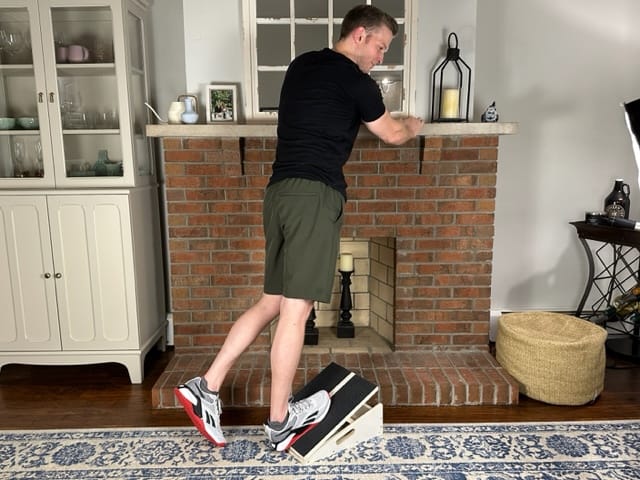
- Purpose: A more aggressive calf stretch than strap-based stretching.
- Benefits: Improves knee and ankle mechanics during squatting and walking.
- How to Do It:
- Stand on a slant board with heels down and toes up.
- Lean forward until a stretch is felt in your calves.
- Hold for 20 seconds, repeat 5 times.
- Helpful Link: Best Slant Board can be found in the link below.
2. Goblet Squats
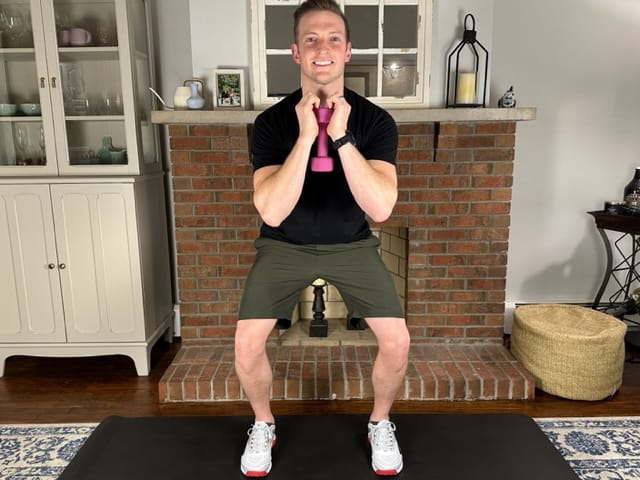
- Purpose: Build quad, glute, and core strength in a functional pattern.
- Benefits: Improves squat mechanics, knee control, and lower body power.
- How to Do It:
- Hold a dumbbell close to your chest with elbows down.
- Squat down slowly, keeping your chest tall and knees aligned.
- Press through your heels to return to standing 10 times, complete 3 sets.
- Helpful Link: Best Dumbbell Weight can be found in the link below.
3. Sidesteps with Band
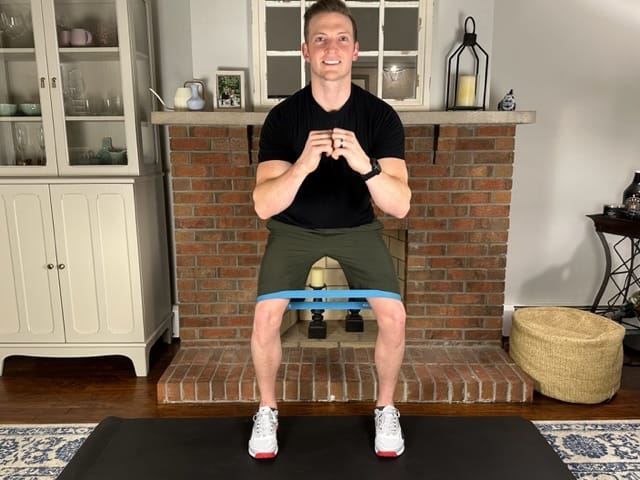
- Purpose: Strengthen hip stabilizers that control lateral knee movement.
- Benefits: Reduces varus stress and improves knee alignment.
- How to Do It:
- Place a resistance band just above your knees and lower into a mini squat.
- Step sideways slowly, keeping tension in the band.
- Perform 12-15 steps in each direction, rest, and repeat 3 times.
- Pro Tip: Keep your feet pointing straight ahead and your knees pressed into the Resistance Band.
4. Step Downs

- Purpose: Trains eccentric quad control for functional activities.
- Benefits: Builds stability for stair descent and athletic motion.
- How to Do It:
- Stand on a step near your counter for light support.
- Slowly lower your opposite heel toward the ground without collapsing at the knee.
- Push through your stance leg to return to the top. Complete 2 sets of 10 reps.
- Pro Tip: Start on the lowest setting of an Adjustable Stepper and slowly increase the height as it gets easy.
Looking for a simple way to stay consistent?
👉 Download the free full LCL Tear Exercise Recovery Program + Exercise Tracker (PDF) to follow all 3 phases and log your daily progress.
Best LCL Sprain Exercises at Home: Final Thoughts
Recovering from an LCL sprain can feel slow, especially when turning or side-stepping still feels unstable. But with a structured, gradual rehab plan, you can reduce pain, restore outer-knee stability, and rebuild confidence.
This phased exercise program mirrors what I prescribe in the clinic—safe, progressive, and effective for supporting LCL healing. Focus on consistency, avoid movements that cause sharp lateral knee pain, and take progress at your own pace. Over time, you should notice improved strength, steadier balance, and a more stable knee during everyday activities.
Why Trust Physical Therapy Simplified for LCL Sprain Recovery Exercises?
At Physical Therapy Simplified, our mission is to provide an accessible, trustworthy source of physical therapy guidance that anyone can understand, follow, and benefit from. We want you to feel confident that you’re getting evidence-based advice and the best exercises for a lateral collateral ligament sprain—all designed to reduce pain and restore your highest functional potential.
This article was written by Andrew Harkins, PT, DPT, OCS, a licensed physical therapist with over twelve years of clinical experience. He is certified by the American Board of Physical Therapy Specialties as an Orthopedic Clinical Specialist and has successfully helped hundreds of patients recover from knee ligament injuries—both with and without surgery.
Andrew has also served as a teaching assistant at the University of Pittsburgh’s Doctor of Physical Therapy Program, where he contributed to musculoskeletal coursework with a special focus on knee rehabilitation and surgical treatment recovery strategies. His knowledge and hands-on experience ensure that the information you’re reading is not only accurate but clinically proven to help.


